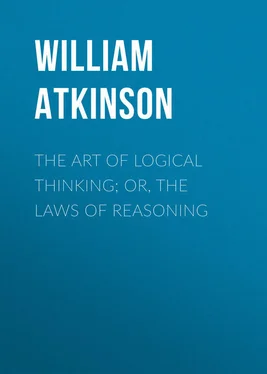William Atkinson - The Art of Logical Thinking; Or, The Laws of Reasoning
Здесь есть возможность читать онлайн «William Atkinson - The Art of Logical Thinking; Or, The Laws of Reasoning» — ознакомительный отрывок электронной книги совершенно бесплатно, а после прочтения отрывка купить полную версию. В некоторых случаях можно слушать аудио, скачать через торрент в формате fb2 и присутствует краткое содержание. Жанр: foreign_antique, foreign_prose, на английском языке. Описание произведения, (предисловие) а так же отзывы посетителей доступны на портале библиотеки ЛибКат.
- Название:The Art of Logical Thinking; Or, The Laws of Reasoning
- Автор:
- Жанр:
- Год:неизвестен
- ISBN:нет данных
- Рейтинг книги:4 / 5. Голосов: 1
-
Избранное:Добавить в избранное
- Отзывы:
-
Ваша оценка:
- 80
- 1
- 2
- 3
- 4
- 5
The Art of Logical Thinking; Or, The Laws of Reasoning: краткое содержание, описание и аннотация
Предлагаем к чтению аннотацию, описание, краткое содержание или предисловие (зависит от того, что написал сам автор книги «The Art of Logical Thinking; Or, The Laws of Reasoning»). Если вы не нашли необходимую информацию о книге — напишите в комментариях, мы постараемся отыскать её.
The Art of Logical Thinking; Or, The Laws of Reasoning — читать онлайн ознакомительный отрывок
Ниже представлен текст книги, разбитый по страницам. Система сохранения места последней прочитанной страницы, позволяет с удобством читать онлайн бесплатно книгу «The Art of Logical Thinking; Or, The Laws of Reasoning», без необходимости каждый раз заново искать на чём Вы остановились. Поставьте закладку, и сможете в любой момент перейти на страницу, на которой закончили чтение.
Интервал:
Закладка:
As Brooks says: "A concept cannot be represented by a concrete image. This is evident from its being general rather than particular. If its color, size or shape is fixed by an image, it is no longer general but particular." And Halleck says: "It is impossible to image anything without giving that image individual marks. The best mental images are so definite that a picture could be painted from them. A being might come under the class man and have a snub nose, blonde hair, scanty eyebrows, and no scar on his face. The presence of one of these individual peculiarities in the concept man would destroy it. If we form an image of an apple, it must be either of a yellow, red, green, or russet apple, either as large as a pippin or as small as a crab-apple. A boy was asked what he thought of when ' apple ' was mentioned. He replied that he thought of 'a big, dark-red, apple with a bad spot on one side, near the top.' That boy could image distinctly, but his power of forming concepts was still in its infancy."
So we see that while a mental image must picture the particular and individual qualities, properties and appearances of some particular unit of a class, a concept can and must contain only the class qualities – that is, the qualities belonging to the entire class. The general concept is as has been said "a general idea … a general notion which has in it all that is common to its own class." And it follows that a "general idea" of this kind cannot be pictured. A picture must be of some particular thing, while a concept is something above and higher than particular things. We may picture a man , but we cannot picture Man the concept of the race. A concept is not a reproduction of the image of a thing , but on the contrary is an idea of a class of things . We trust that the student will consider this point until he arrives at a clear understanding of the distinction, and the reason thereof.
But, while a concept is incapable of being pictured mentally as an image, it is true that some particular representative of a class may be held in the mind or imagination as an idealized object , as a general representative of the class, when we speak or think of the general term or concept, providing that its real relation to the concept is recognized. These idealized objects, however, are not concepts – they are percepts reproduced by the memory. It is important, however, to all who wish to convey their thought plainly, that they be able to convert their concepts into idealized representative objects. Otherwise, they tend to become too idealistic and abstract for common comprehension. As Halleck well says: "We should in all cases be ready to translate our concepts, when occasion requires, into the images of those individuals which the concept represents. A concept means nothing except in reference to certain individuals. Without them it could never have had existence and they are entitled to representation. A man who cannot translate his concepts into definite images of the proper objects, is fitted neither to teach, preach, nor practice any profession… There was, not long ago, a man very fond of talking about fruit in the abstract; but he failed to recognize an individual cranberry when it was placed before him. A humorist remarked that a certain metaphysician had such a love for abstractions, and such an intense dislike for concrete things, as to refuse to eat a concrete peach when placed before him."
In the beginning many students are perplexed regarding the difference between a percept and a concept . The distinction is simple when properly considered. A percept is: "the object of an act of perception; that which is perceived." A concept is: "a mental representation." Brooks makes the following distinction: "A percept is the mental product of a real thing; a concept is a mere idea or notion of the common attributes of things. A percept represents some particular object; a concept is not particular, but general. A percept can be described by particulars; a concept can be described only by generals. The former can usually be represented by an image, the latter cannot be imagined, it can only be thought ." Thus one is able to image the percept of a particular horse which has been perceived; but he is unable to image correctly the concept of horse as a class or generic term.
In connection with this distinction between perception and conception , we may as well consider the subject of apperception , a term favored by many modern psychologists, although others steadfastly decline to recognize its necessity or meaning and refuse to employ it. Apperception may be defined as: "perception accompanied by comprehension; perception accompanied by recognition." The thing perceived is held to be comprehended or recognized – that is, perceived in a new sense , by reason of certain previously acquired ideas in the mind. Halleck explains it as: "the perception of things in relation to the ideas which we already possess." It follows that all individuals possessed of equally active organs of perception, and equally active attention, will perceive the same thing in the same way and in the same degree. But the apperception of each individual will differ and vary according to his previous experience and training, temperament and taste, habit and custom. For instance, the familiar story of the boy who climbed a tree and watched the passers-by, noting their comments. The first passer-by noticing the tree, says aloud: "That would make a good stick of timber." "Good morning, Mr. Carpenter," said the boy. The next man said: "That tree has fine bark." "Good morning, Mr. Tanner," said the boy. Another said, "I bet there's a squirrel's nest up in that tree." "Good morning, Mr. Hunter," said the boy.
The woman sees in a bird something pretty and "cunning." The hunter sees in it something to kill. The ornithologist sees it as something of a certain genus and species, and perhaps also as something appropriate for his collection. The farmer perceives it to be something destructive of either insects or crops. A thief sees a jail as something to be dreaded; an ordinary citizen, something useful for confining objectionable people; a policeman, something in the line of his business. And so on, the apperception differing upon the previous experience of the individual. In the same way the scientist sees in an animal or rock many qualities of which the ordinary person is ignorant. Our training, experience, prejudices, etc., affect our apperception.
And so, we see that in a measure our concepts are determined not only by our simple perceptions, but also materially by our apperceptions. We conceive things not only as they are apparent to our senses, but also as colored and influenced by our previous impressions and ideas. For this reason we find widely varying concepts of the same things among different individuals. Only an absolute mind could form an absolute concept.
Конец ознакомительного фрагмента.
Текст предоставлен ООО «ЛитРес».
Прочитайте эту книгу целиком, купив полную легальную версию на ЛитРес.
Безопасно оплатить книгу можно банковской картой Visa, MasterCard, Maestro, со счета мобильного телефона, с платежного терминала, в салоне МТС или Связной, через PayPal, WebMoney, Яндекс.Деньги, QIWI Кошелек, бонусными картами или другим удобным Вам способом.
Интервал:
Закладка:
Похожие книги на «The Art of Logical Thinking; Or, The Laws of Reasoning»
Представляем Вашему вниманию похожие книги на «The Art of Logical Thinking; Or, The Laws of Reasoning» списком для выбора. Мы отобрали схожую по названию и смыслу литературу в надежде предоставить читателям больше вариантов отыскать новые, интересные, ещё непрочитанные произведения.
Обсуждение, отзывы о книге «The Art of Logical Thinking; Or, The Laws of Reasoning» и просто собственные мнения читателей. Оставьте ваши комментарии, напишите, что Вы думаете о произведении, его смысле или главных героях. Укажите что конкретно понравилось, а что нет, и почему Вы так считаете.












